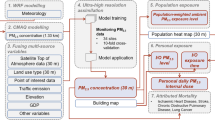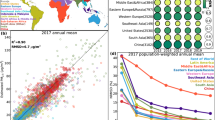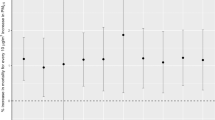Abstract
Background
Improved understanding of sources and processes that drive exposure contrast of fine particulate matter (PM2.5) is essential for designing and interpreting epidemiological study outcomes.
Objective
We investigate the contribution of various sources and processes to PM2.5 exposure contrasts at different spatial scales across the continental United States.
Methods
We consider three cases: exposure contrast within a metro area, nationwide exposure contrast with high spatial resolution, and nationwide exposure contrast with low spatial resolution. Using national empirical model estimates of source- and chemically specific PM2.5 concentration predictions, we quantified the contribution of various sources and processes to PM2.5 exposure contrasts in these three cases.
Results
At the metro level (i.e., metropolitan statistical area; MSA), exposure contrasts of PM2.5 vary between −1.8 to 1.4 µg m−3 relative to the MSA-mean with about 50% of within-MSA exposure contrast of PM2.5 caused by cooking and mobile source primary PM2.5. For the national exposure contrast at low-resolution (i.e., using MSA-average mean concentrations), exposure contrasts (relative to the national mean: −3.9 to 3.2 µg m−3) are larger than within an MSA with ~80% of the variation due to secondary PM2.5. National exposure contrast at high resolution (census block) has the largest absolute range (relative to the national mean: −4.7 to 3.7 µg m−3) due to both regional and intra-urban contributions; on average, 65% of the national exposure contrast is due to secondary PM2.5 with the remaining from the primary PM2.5 (cooking and mobile source 26%, other 9%).
Impact
Our study provides a comprehensive analysis of the sources and processes that contribute to exposure contrasts of PM2.5 across different geographic areas in the US. For the first time on a national scale, we used high spatial resolution source-specific exposure estimates to identify the primary contributors to PM2.5 exposure contrasts. The study also highlights the advantages of different study designs for investigating the health impacts of specific PM2.5 components. The findings provide novel insights that can inform public health policies aimed at reducing PM2.5 exposure and advance the understanding of the epidemiological study outcomes.
This is a preview of subscription content, access via your institution
Access options
Subscribe to this journal
Receive 6 print issues and online access
$259.00 per year
only $43.17 per issue
Buy this article
- Purchase on Springer Link
- Instant access to full article PDF
Prices may be subject to local taxes which are calculated during checkout






Similar content being viewed by others
Data availability
All data needed to evaluate the findings in the paper are present in the main text and/or the Supplementary Materials. Additional data (predicted census block-level concentrations) related to this paper can be requested from the authors.
References
Dockery DW, Pope CA, Xu X, Spengler JD, Ware JH, Fay ME, et al. An association between air pollution and mortality in six U.S. cities. N Engl J Med. 1993;329:1753–9.
Pope CA III, Burnett RT, Thun MJ, Calle EE, Krewski D, Ito K, et al. Lung cancer, cardiopulmonary mortality, and long-term exposure to fine particulate air pollution. JAMA. 2002;287:1132–41.
Pope CA III, Dockery DW. Health effects of fine particulate air pollution: lines that connect. J Air Waste Manag Assoc. 2006;56:709–42.
Pope CA, Ezzati M, Dockery DW. Fine-particulate air pollution and life expectancy in the United States. N Engl J Med. 2009;360:376–86.
Pope CA, Coleman N, Pond ZA, Burnett RT. Fine particulate air pollution and human mortality: 25+ years of cohort studies. Environ Res. 2019;183:108924.
Bennett JE, Tamura-Wicks H, Parks RM, Burnett RT, Iii CAP, Bechle MJ, et al. Particulate matter air pollution and national and county life expectancy loss in the USA: a spatiotemporal analysis. PLOS Med. 2019;16:e1002856.
Pope CA, Cohen AJ, Burnett RT. Cardiovascular disease and fine particulate matter: lessons and limitations of an integrated exposure response approach. Circ Res. 2018;122:1645–7.
HEI. Understanding the health effects of components of the particulate matter mix: progress and next steps. Health Eff. Inst. 2002.https://www.healtheffects.org/publication/understanding-health-effects-components-particulate-matter-mix-progress-and-next-steps. Accessed 27 Jun 2021.
Bell ML, HEI Health Review Committee. Assessment of the health impacts of particulate matter characteristics. Res Rep Health Eff Inst. 2012;161:5–38.
West JJ, Cohen A, Dentener F, Brunekreef B, Zhu T, Armstrong B, et al. What We Breathe Impacts Our Health: Improving Understanding of the Link between Air Pollution and Health. Environ Sci Technol. 2016;50:4895–904.
HEI. Understanding the Health Effects of Ambient Ultrafine Particles. HEI; 2013.https://www.healtheffects.org/publication/understanding-health-effects-ambient-ultrafine-particles. Accessed 13 Aug 2019.
Lippmann M, Chen L-C, Gordon T, Ito K, Thurston GD. National Particle Component Toxicity (NPACT) Initiative: integrated epidemiologic and toxicologic studies of the health effects of particulate matter components. Res Rep Health Eff Inst 2013;177: 5–13.
Pond ZA, Hernandez CS, Adams PJ, Pandis SN, Garcia GR, Robinson AL, et al. Cardiopulmonary mortality and fine particulate air pollution by species and source in a National U.S. cohort. Environ Sci Technol. 2022;56:7214–23.
Pond ZA, Saha PK, Coleman CJ, Presto AA, Robinson AL, Arden Pope III C. Mortality risk and long-term exposure to ultrafine particles and primary fine particle components in a national U.S. Cohort. Environ Int. 2022;167:107439.
Krall JR, Chang HH, Sarnat SE, Peng RD, Waller LA. Current methods and challenges for epidemiological studies of the associations between chemical constituents of particulate matter and health. Curr Environ Health Rep. 2015;2:388–98.
Krewski D, Jerrett M, Burnett RT, Ma R, Hughes E, Shi Y, et al. Extended follow-up and spatial analysis of the American Cancer Society study linking particulate air pollution and mortality. Res Rep Health Eff Inst. 2009;5:114. discussion 115–36
Jerrett M, Burnett RT, Ma R, Pope CA, Krewski D, Newbold KB, et al. Spatial analysis of air pollution and mortality in Los Angeles. Epidemiol Camb Mass. 2005;16:727–36.
Lepeule J, Laden F, Dockery D, Schwartz J. Chronic exposure to fine particles and mortality: an extended follow-up of the Harvard Six Cities study from 1974 to 2009. Environ Health Perspect. 2012;120:965–70.
Pope CA, Ezzati M, Cannon JB, Allen RT, Jerrett M, Burnett RT. Mortality risk and PM2.5 air pollution in the USA: an analysis of a national prospective cohort. Air Qual Atmosphere Health. 2018;11:245–52.
Pope CA, Lefler JS, Ezzati M, Higbee JD, Marshall JD, Kim S-Y, et al. Mortality risk and fine particulate air pollution in a large, representative cohort of U.S. adults. Environ Health Perspect. 2019;127:77007.
Jerrett M, Burnett RT, Beckerman BS, Turner MC, Krewski D, Thurston G, et al. Spatial analysis of air pollution and mortality in California. Am J Respir Crit Care Med. 2013;188:593–9.
Zeger SL, Dominici F, McDermott A, Samet JM. Mortality in the Medicare population and chronic exposure to fine particulate air pollution in urban centers (2000-5). Environ Health Perspect. 2008;116:1614–9.
Apte JS, Messier KP, Gani S, Brauer M, Kirchstetter TW, Lunden MM, et al. High-resolution air pollution mapping with google street view cars: exploiting big data. Environ Sci Technol. 2017;51:6999–7008.
Saha PK, Presto AA, Hankey S, Murphy BN, Allen C, Zhang W, et al. National exposure models for source-specific primary particulate matter concentrations using aerosol mass spectrometry data. Environ Sci Technol. 2022;56:14284–95.
Wang Y, Bechle MJ, Kim S-Y, Adams PJ, Pandis SN, Pope CA, et al. Spatial decomposition analysis of NO2 and PM2.5 air pollution in the United States. Atmos Environ. 2020;241:117470.
Pinto JP, Lefohn AS, Shadwick DS. Spatial variability of PM2.5 in Urban Areas in the United States. J Air Waste Manag Assoc. 2004;54:440–9.
Kim S-Y, Bechle M, Hankey S, Sheppard L, Szpiro AA, Marshall JD. Concentrations of criteria pollutants in the contiguous U.S., 1979 – 2015: Role of prediction model parsimony in integrated empirical geographic regression. PLOS ONE. 2020;15:e0228535.
Gu P, Li HZ, Ye Q, Robinson ES, Apte JS, Robinson AL, et al. Intracity variability of particulate matter exposure is driven by carbonaceous sources and correlated with land-use variables. Environ Sci Technol. 2018;52:11545–54.
Sun Y-L, Zhang Q, Schwab JJ, Demerjian KL, Chen W-N, Bae M-S, et al. Characterization of the sources and processes of organic and inorganic aerosols in New York city with a high-resolution time-of-flight aerosol mass apectrometer. Atmos Chem Phys. 2011;11:1581–602.
Ulbrich IM, Canagaratna MR, Zhang Q, Worsnop DR, Jimenez JL. Interpretation of organic components from Positive Matrix Factorization of aerosol mass spectrometric data. Atmos Chem Phys. 2009;9:2891–918.
Eeftens M, Beelen R, de Hoogh K, Bellander T, Cesaroni G, Cirach M, et al. Development of land use regression models for PM2.5, PM2.5 absorbance, PM10 and PMcoarse in 20 European study areas; results of the ESCAPE project. Environ Sci Technol. 2012;46:11195–205.
Saha PK, Li HZ, Apte JS, Robinson AL, Presto AA. Urban ultrafine particle exposure assessment with land-use regression: influence of sampling strategy. Environ Sci Technol. 2019;53:7326–36.
US EPA O. 2017 National Emissions Inventory (NEI) Data. 2017. https://www.epa.gov/air-emissions-inventories/2017-national-emissions-inventory-nei-data. Accessed 1 Dec 2022.
Zhang Q, Jimenez JL, Canagaratna MR, Ulbrich IM, Ng NL, Worsnop DR, et al. Understanding atmospheric organic aerosols via factor analysis of aerosol mass spectrometry: a review. Anal Bioanal Chem. 2011;401:3045–67.
Shah RU, Robinson ES, Gu P, Robinson AL, Apte JS, Presto AA. High-spatial-resolution mapping and source apportionment of aerosol composition in Oakland, California, using mobile aerosol mass spectrometry. Atmos Chem Phys. 2018;18:16325–44.
Lim H-J, Turpin BJ. Origins of primary and secondary organic aerosol in atlanta: results of time-resolved measurements during the Atlanta supersite experiment. Environ Sci Technol. 2002;36:4489–96.
Zhao Y, Tkacik DS, May AA, Donahue NM, Robinson AL. Mobile sources are still an important source of secondary organic aerosol and fine particulate matter in the Los Angeles region. Environ Sci Technol. 2022;56:15328–36.
Aiken AC, DeCarlo PF, Kroll JH, Worsnop DR, Huffman JA, Docherty KS, et al. O/C and OM/OC ratios of primary, secondary, and ambient organic aerosols with high-resolution time-of-flight aerosol mass spectrometry. Environ Sci Technol. 2008;42:4478–85.
Hayes PL, Ortega AM, Cubison MJ, Froyd KD, Zhao Y, Cliff SS, et al. Organic aerosol composition and sources in Pasadena, California, during the 2010 CalNex campaign. J Geophys Res Atmospheres. 2013;118:9233–57.
Habre R, Girguis M, Urman R, Fruin S, Lurmann F, Shafer M, et al. Contribution of tailpipe and non-tailpipe traffic sources to quasi-ultrafine, fine and coarse particulate matter in southern California. J Air Waste Manag Assoc. 2021;71:209–30.
Fussell JC, Franklin M, Green DC, Gustafsson M, Harrison RM, Hicks W, et al. A review of road traffic-derived non-exhaust particles: emissions, physicochemical characteristics, health risks, and mitigation measures. Environ Sci Technol. 2022;56:6813–35.
Wang X, Gronstal S, Lopez B, Jung H, Chen L-WA, Wu G, et al. Evidence of non-tailpipe emission contributions to PM2.5 and PM10 near southern California highways. Environ Pollut. 2023;317:120691.
Goldstein AH, Koven CD, Heald CL, Fung IY. Biogenic carbon and anthropogenic pollutants combine to form a cooling haze over the southeastern United States. Proc Natl Acad Sci. 2009;106:8835–40.
Hoek G. Methods for assessing long-term exposures to outdoor air pollutants. Curr Environ Health Rep. 2017;4:450–62.
Saha PK, Hankey S, Marshall JD, Robinson AL, Presto AA. High-spatial-resolution estimates of ultrafine particle concentrations across the continental United States. Environ Sci Technol. 2021;55:10320–31.
Acknowledgements
This research is part of the Center for Air, Climate, and Energy Solutions (CACES), which was supported by the Environmental Protection Agency (assistance agreement number RD83587301). It has not been formally reviewed by EPA. The views expressed in this document are solely those of authors and do not necessarily reflect those of the Agency. EPA does not endorse any products or commercial services mentioned in this publication.
Author information
Authors and Affiliations
Contributions
PKS, AAP, and ALR designed research; PKS, AAP, and ALR performed research; PKS analyzed data; and PKS, AAP, and ALR wrote the paper.
Corresponding author
Ethics declarations
Competing interests
The authors declare no competing interests.
Additional information
Publisher’s note Springer Nature remains neutral with regard to jurisdictional claims in published maps and institutional affiliations.
Supplementary information
Rights and permissions
Springer Nature or its licensor (e.g. a society or other partner) holds exclusive rights to this article under a publishing agreement with the author(s) or other rightsholder(s); author self-archiving of the accepted manuscript version of this article is solely governed by the terms of such publishing agreement and applicable law.
About this article
Cite this article
Saha, P.K., Presto, A.A. & Robinson, A.L. Hyper-local to regional exposure contrast of source-resolved PM2.5 components across the contiguous United States: implications for health assessment. J Expo Sci Environ Epidemiol (2023). https://doi.org/10.1038/s41370-023-00623-0
Received:
Revised:
Accepted:
Published:
DOI: https://doi.org/10.1038/s41370-023-00623-0



